Middle Table Decor: Transforming Your Space
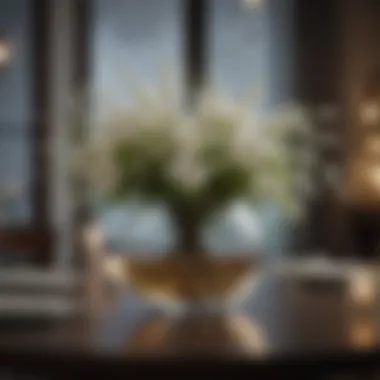
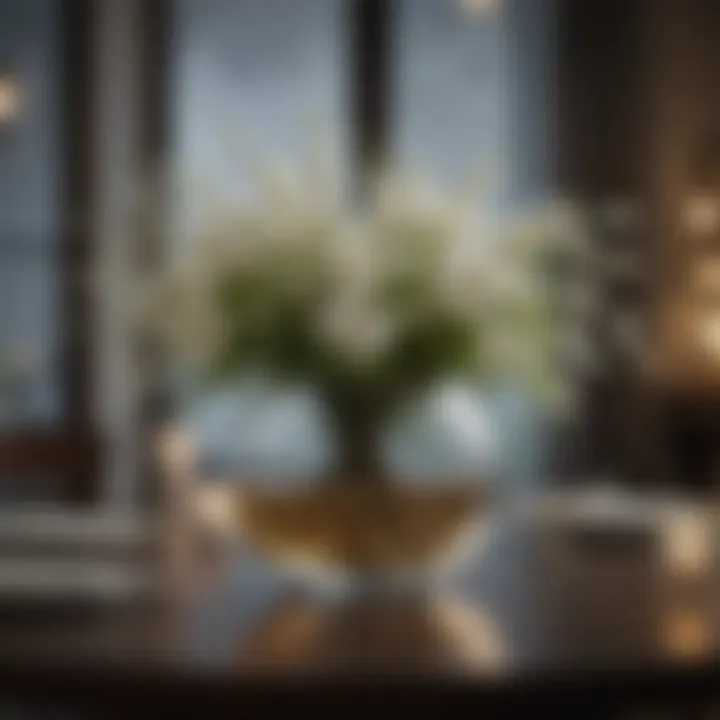
Intro
Middle table decor serves as a focal point in various environments, significantly influencing the overall aesthetic of a space. The middle table, often a central feature in living rooms, dining areas, or patios, requires thoughtful decor planning. This guide aims to provide an extensive understanding of how to enhance these spaces through decor choices that resonate with personal style and elevate functionality.
Design Inspiration
Current Interior Design Trends
When considering middle table decor, it is important to stay updated on current design trends. Minimalism continues to dominate, emphasizing clean lines and clutter-free surfaces. This trend includes furniture pieces made from natural materials such as wood or stone, which bring a sense of warmth and organic beauty to the decor.
In contrast, maximalism, with its bold colors and eclectic items, creates a vibrant setting. Mixing textures and patterns can enhance visual interest. Choosing decor that merges these styles can create a balanced atmosphere that feels inviting.
Color Palettes and Their Effects
Color plays a critical role in middle table decor. A well-chosen palette can set the mood of the entire room. For instance, neutral tones like soft whites and greys provide a calming effect, suitable for relaxed settings. Adding occasional pops of color, such as vibrant greens or deep blues, can energize the space while still maintaining harmony.
- Cool Colors: Blues and greens can create a sense of tranquility.
- Warm Colors: Reds and oranges stimulate energy and conversation.
- Monochromatic Schemes: Different shades of a single color enhance coherence.
Each of these options offers a different ambiance, allowing homeowners to select what fits their style best.
"Thoughtful decor not only beautifies a space, but also serves to enhance the functionality of everyday living."
Entertaining Ideas
Themed Party Concepts
For those who enjoy hosting, middle table decor plays a vital role in setting the stage for gatherings. Themed parties can be elevated with carefully planned table setups. For example, a rustic Italian dinner can feature olive branches and terracotta dishes, while a modern cocktail party might use sleek glassware and geometric designs.
Menu Planning and Recipes
Selecting the right menu complements the decor. When planning for an event, consider recipes that match the theme. A simple yet elegant cheese and charcuterie board can work well for various occasions, aligning with the table's decor while offering tactile and visual appeal.
Understanding the Middle Table's Role in Interior Design
The middle table, often overlooked in the grand scheme of interior design, plays a vital role in how spaces are perceived and utilized. This article will explore the importance of middle tables, focusing on their functionality and aesthetic contributions. Understanding their multifaceted roles assists home owners, design enthusiasts, and hosts in creating environments that reflect their personal taste while serving practical purposes.
The Functionality of a Middle Table
The functionality of a middle table extends beyond mere aesthetics. It acts as a central hub in a room, inviting interaction and facilitating various activities. Middle tables can be used for displaying items, serving food and drinks, or even as a workspace for light tasks. These pieces often serve as a bridge between different seating areas, making them essential in spaces like living rooms and family areas.
Some specific functions of middle tables include:
- Social Interaction: They encourage conversation and connection among guests.
- Display Space: Middle tables can showcase decorative items, books, or plants, enhancing the visual appeal of a room.
- Storage Solutions: Many middle tables come with drawers or shelving, providing functional storage for magazines, remote controls, or coasters.
Aesthetic Contributions of a Central Table
The aesthetic contributions of a central table are profound. This piece can tie together the overall design theme of a room. Depending on its style, material, and accessories, a middle table can convey warmth, sophistication, or modernity. It can either stand out as a focal point or blend seamlessly into the surrounding décor.
Key aesthetic considerations include:
- Style Variety: Middle tables are available in countless designs, from traditional to contemporary, allowing homeowners to select one that complements their existing decor.
- Material Impact: The choice of material—wood, glass, or metal—can greatly affect the ambiance. For example, a wooden table might create a cozy feel, while a glass one offers a sleek, modern touch.
- Color Coordination: The color of the table can harmonize or contrast with other elements in the space, influencing the room’s overall mood.
"A well-chosen middle table not only enhances functionality but also serves as a statement piece in any room."
When designing a space, it is crucial to consider how a middle table serves both practical and aesthetic functions. Whether it becomes the focus of gatherings or a canvas for decorative expression, its role cannot be underestimated.
Materials That Define Middle Tables
The choice of materials for a middle table plays a significant role in both aesthetics and functionality. Each material brings its own unique characteristics, influencing the overall look and feel of the space. Understanding these elements can help homeowners and interior design enthusiasts create a coherent design that complements their living area.
The materials used in middle tables not only dictate their appearance but also their durability and maintenance requirements. Factors such as texture, color, and structural qualities should be considered when selecting the best option for your decor. Whether you prefer a modern vibe or something more rustic, the materials you choose can make a profound impact on the room's ambiance.
Wood: Timeless Elegance
Wooden tables have an inherent charm that appeals to many. They are often associated with warmth and comfort, providing a welcoming atmosphere. Various types of wood, like oak, walnut, or mahogany, offer different grains and colors, allowing for personalization.
The most attractive aspect of wood is its versatility. It can fit various styles, from traditional to contemporary. Unlike synthetic materials, wood develops a unique character over time. Scratches or dents can add to its story instead of diminishing its value.
However, wood does require maintenance. Regular polishing can keep it looking fresh, while preventing moisture can extend its lifespan. If you’re looking for a durable, elegant option, wooden middle tables might be the perfect choice.
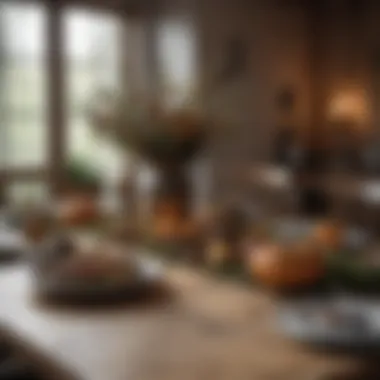
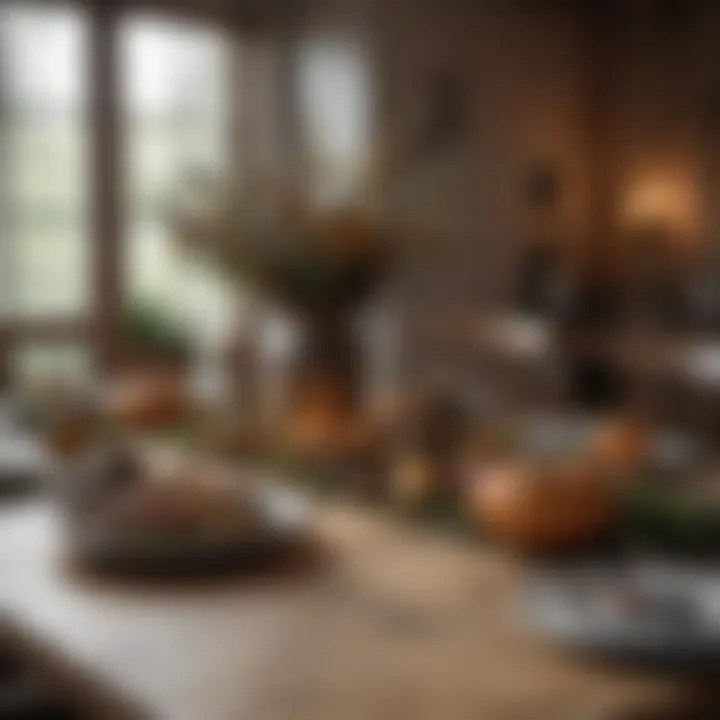
Glass: Contemporary Appeal
Glass tables are known for their sleek and modern aesthetic. They can create a sense of space and light, making smaller rooms feel larger. A glass top allows for visibility of what’s underneath, which can be utilized for decorative purposes.
This material is often paired with metal or wood bases, enhancing its appeal. It's important to recognize that while glass is visually attractive, it does come with its drawbacks. Fingerprints and dust are more visible, demanding regular cleaning. Additionally, glass can be fragile, so careful placement of items is necessary.
For those who appreciate a minimalist approach, glass tables offer an unobtrusive yet stylish solution.
Metal: Industrial Flair
Metal middle tables convey a strong, industrial vibe, appealing to those who favor contemporary design. They come in various finishes, such as matte or brushed, adding to their character. Metal is exceptionally durable and can withstand wear and tear over time.
An advantage of metal tables is their ease of maintenance. They typically require little more than a quick wipe-down to keep them looking their best. However, it’s essential to consider the type of metal. Some can scratch easier than others, and rust could be a concern depending on the finish.
Metal-middle tables work well in urban settings or lofts where a bold statement is desired.
Mixed Materials: Creating Contrast
Combining different materials in middle table construction can yield stunning results. A mixed material table can incorporate wood, glass, and metal, providing a diverse aesthetic that draws the eye. This combination can balance warmth and coolness, making the decor more dynamic.
When mixing materials, the key is to find harmony. Choosing materials that complement each other in color or texture can enhance visual appeal. Mixed material tables also allow for more creativity, offering endless possibilities to cater to personal tastes.
In summary, the materials defined for middle tables affect their overall impact and functionality. Each offers distinct advantages and challenges, presenting choices that can significantly influence one’s home decor.
Styling Themes for Middle Table Decor
Selecting the right styling theme for middle table decor plays a critical role in establishing the ambiance of a living space. A well-chosen theme not only enhances the table's aesthetic appeal but also reflects the personality of the homeowner. Various styling themes signal different moods and atmospheres, making it important to align them with personal taste and the overall design of the room.
When exploring themes, consider factors like color, texture, and coherence with surrounding decor. Moreover, the arrangement of accessories should relate to the chosen theme to create a unified look. This section examines several stylish themes, providing insights into their unique characteristics and suitable applications.
Minimalist Approach
The minimalist approach to middle table decor emphasizes simplicity and functionality. This style uses fewer elements to create an uncluttered, serene environment. A good minimalist design often incorporates neutral colors and straight lines, allowing the table to complement rather than compete with other room features.
Key features of a minimalist approach include:
- A limited number of decorative items: Often one or two pieces, such as a single vase or a geometric sculpture.
- Neutral color palette: Whites, greys, and soft earth tones work harmoniously.
- Clean lines and forms: Choosing furniture and accessories that are sleek and unobtrusive.
The benefit of a minimalist theme is its timeless quality, offering long-lasting appeal and ease of updating decor as trends change.
Bohemian Vibes
Bohemian decor, or "boho," invites warmth and creativity into the living space. This theme allows for diverse elements, combining colors, patterns, and textures. With the bohemian style, homeowners can express individuality through eclectic combinations that reflect personal travels and experiences.
Common aspects to consider with bohemian styling include:
- Layered textiles: Use table runners, placemats, and fabric drapes in varied textures and patterns.
- Colorful accessories: Bright vases, artistic figurines, and unique trinkets show personality.
- Plants and nature elements: Incorporate greenery and natural materials, such as wood and stone.
The key advantage of a bohemian theme is its flexibility. Each table setup can be unique and inspiring, creating a welcoming space perfect for gatherings.
Classic Touches
Classic decor embodies sophistication and timeless elegance. This theme often utilizes traditional colors and materials, providing a refined atmosphere that never goes out of style. Homeowners who prefer classical touches often opt for items with intricate details and craftsmanship.
Elements to enhance classic styling include:
- Quality materials: Think marble, crystal, or rich woods that add opulence.
- Coordinated color scheme: Colors like navy, gold, and burgundy create a luxurious feel.
- Traditional accessories: Use items like candlesticks, antique vases, or framed family photos.
Classic touches elevate the middle table's decor, ensuring a polished look that can impress guests.
Modern Chic
Modern chic decor combines contemporary design principles with innovative accessories. It often features bold colors, unexpected shapes, and cutting-edge materials. This theme is perfect for homeowners who appreciate current trends while aiming for a cohesive design.
Characteristics include:
- Sleek furniture: Choose tables with angular designs or unusual shapes.
- Bold statement pieces: Use eye-catching decor like oversized art or sculptural objects.
- Metallic accents: Incorporate gold, silver, or copper finishes for added flair.
The modern chic theme is not only eye-catching but also allows for personalization through inventive arrangements and accessories.
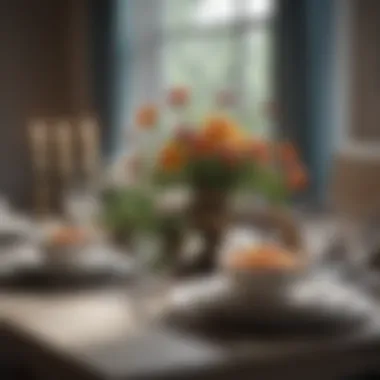
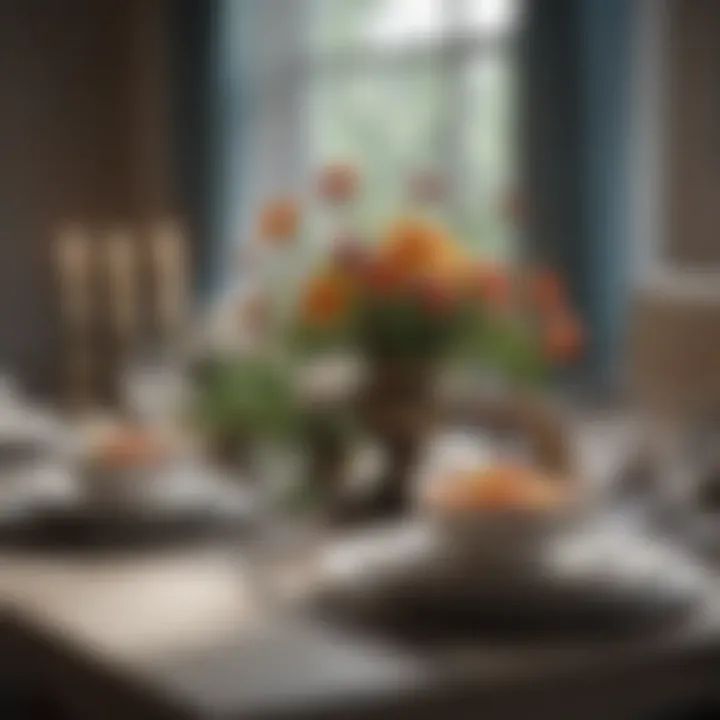
Eclectic Compositions
An eclectic composition encourages homeowners to mix various styles, creating a visually stimulating decor that tells a story. This theme is adaptable and is ideal for those unable to settle on a single aesthetic while enjoying the fluidity of different styles.
Include the following in an eclectic arrangement:
- Varied textures: Combine ceramics, glass, and textiles for a rich feel.
- Contrasting colors: Use both harmonizing and clashing colors to add interest.
- Diverse decorative items: Integrate personal collections or souvenirs from travels.
The primary benefit of an eclectic style is its expressiveness. A middle table under this theme always tells a unique story and showcases the homeowner's creativity.
Choosing the Right Accessories for Middle Tables
Choosing the right accessories for middle tables is an essential aspect of interior design that often goes unrecognized. A middle table serves not only as a functional piece but as a canvas for self-expression and style. The right accessories can enhance the visual appeal of any room while providing utility and character.
When selecting accessories, consider the theme of the room, the size of the table, and the overall decor. These factors dictate how accessories work together. Accessories can vary from simple decorative pieces to practical items that enhance usability. The goal is to maintain a sense of harmony without overcrowding the table.
Centerpieces: The Focal Point
Centerpieces are crucial in defining the character of the middle table. They serve as the focal point and draw attention. A well-chosen centerpiece can encapsulate the theme of the room. This item should reflect personal taste and complement the surrounding space.
Popular options for centerpieces include:
- Floral Arrangements: Fresh or dried flowers add color and life.
- Vases: A striking vase can serve as an artistic element on its own.
- Bowls and Trays: These can hold smaller items, providing both function and beauty.
It is advisable to select centerpieces that match the scale of the table. Overly large pieces may overwhelm the space, while tiny items can get lost. Balance is key.
Table Linens and Mats
Linens and mats are vital to enhancing the tactile experience of a table. They can introduce texture and warmth. Materials such as cotton, linen, and even silk can dramatically change the feel of the table.
When choosing table linens, consider the following:
- Color: Neutral tones offer a sophisticated look, while vibrant shades can add a pop of color.
- Patterns: Simple patterns often work better than busy designs, keeping the focus on other accessories.
- Functionality: Linens also protect the surface of the table from scratches and spills.
Using a well-chosen table mat or tablecloth can create an attractive base for your accessories while allowing the entire arrangement to flow.
Candles and Lighting Options
Candles and lighting options can transform a middle table by adding ambiance and warmth. They can be both decorative and functional, particularly in social settings.
Consider the following options:
- Candles of Different Heights: Varying heights creates a more dynamic look.
- Candlestick Holders: These enhance the elegance of candles and can serve as decorative elements themselves.
- Table Lamps: A small lamp can bring both light and style. This is particularly useful in living rooms or dining areas at night.
Placement is important. Avoid placing candles too close together, as this might create a cluttered look. Proper spacing can enhance visual appeal as well as safety.
Artistic Objects and Sculptures
Artistic objects, including sculptures and unique artifacts, can inject personality into a middle table. These items tell a story about the homeowner's preferences and experiences.
When selecting artistic objects, keep these points in mind:
- Purpose: Choose pieces that resonate personally or have meaning.
- Scale and Proportion: Ensure they fit the size of the table; too small can look lost, whereas too large can be overpowering.
- Material and Texture: Consider how the different materials interact with the table's surface and other accessories.
Integrating sculptures or unique art pieces can turn a functional table into a conversation starter.
The right accessories for your middle table can transform a simple piece of furniture into a stunning visual centerpiece.
Arranging Middle Table Decor Effectively
Arranging middle table decor effectively is crucial in achieving a harmonious and inviting living space. The arrangement can significantly influence the overall aesthetic and functionality of a middle table. It serves as a focal point, drawing attention and setting the tone for the room. Understanding how to arrange decor can help create a refined atmosphere while ensuring it remains practical for daily use.
Balance and Symmetry in Arrangement
Balance and symmetry are key principles in design that enhance the visual appeal of table decor. Establishing balance involves distributing visual weight evenly on the table. This can be done by placing items of varying sizes and shapes in a way that feels cohesive. Symmetry often adds sophistication by positioning matching pairs of objects on either side of the table. For example, two identical candle holders can be placed at either end to create a sense of order.
Consider using visual weights such as larger vases or sculptures, juxtaposed with smaller items like coasters or decorative stones. When balanced properly, the arrangement results in a unified look that can evoke a sense of calm and elegance.
Creating Layered Heights
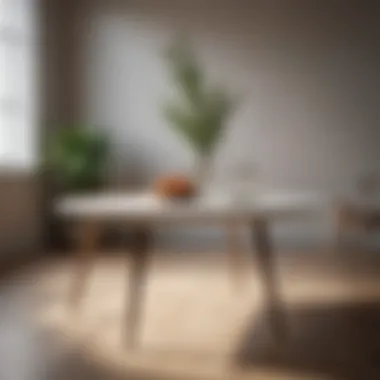
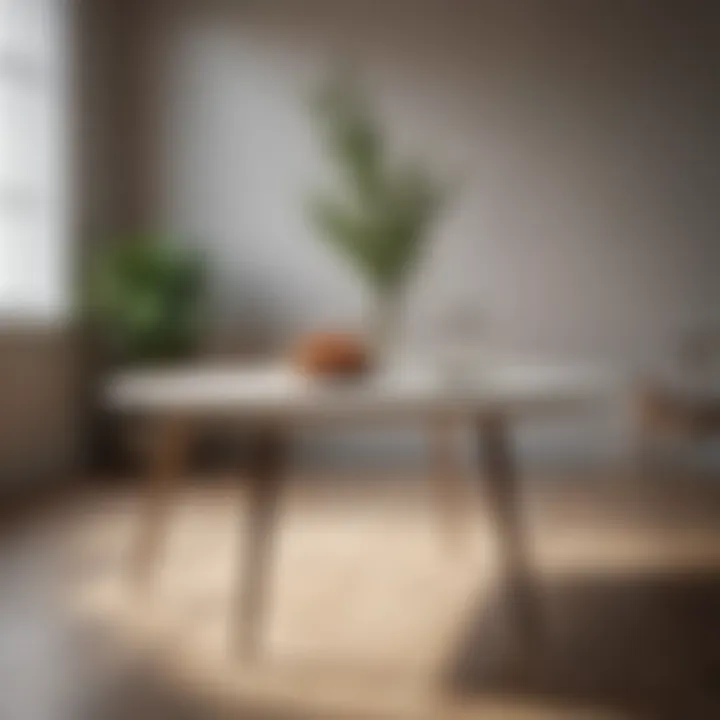
Creating layered heights is another effective strategy for middle table decor. Varying the heights of objects can add depth and interest to the arrangement. This technique encourages the eye to explore the decor, making it more engaging.
To achieve this, select items of different heights. A tall plant may stand next to a low bowl, while a medium-height sculpture could anchor the center. It's important to ensure that the tallest items do not obstruct views across the table. This layering enhances the decor visually and can maximize functional space for items like drinks or snacks during gatherings.
Utilizing Negative Space
Utilizing negative space can elevate the arrangement by allowing the decor to breathe. Negative space is the unoccupied area around objects, which can enhance focus and prevent a cluttered look. Avoid overloading the table with too many items; instead, leave some spaces empty to allow each piece to stand out.
For example, after placing a centerpiece, consider positioning smaller elements in a way that creates a balance but also respects the surrounding empty spaces. This approach can result in an elegant presentation, giving each item its deserved attention without overwhelming the viewer.
Maintaining Middle Table Decor
Maintaining middle table decor is crucial in preserving both the aesthetic appeal and functional integrity of your living space. A middle table often acts as the focal point of a room, so its upkeep reflects your style and care for your environment. When a table is well-maintained, it enhances the overall ambiance, making it inviting for guests while also serving practical purposes. Regular attention to decor can lead to longevity and an ever-fresh look, which is essential for creating a pleasing home atmosphere.
Cleaning and Care for Different Materials
Different materials require specific cleaning methods to maintain their appearance and extend their life. Below is a summary of common materials used in middle tables and tips on how to care for them:
- Wood: Use a soft, damp cloth followed by a dry one to avoid moisture damage. For deeper cleaning, apply a wood cleaner that suits the type of finish. Avoid abrasive materials that could scratch the surface.
- Glass: Regularly wipe with a glass cleaner to prevent streaks. Use a microfiber cloth to avoid scratches. If dealing with tough spots, a mixture of water and vinegar can be effective.
- Metal: Depending on the type of metal, either a damp cloth or a metal polish will suffice for cleaning. For rust, use a rust remover and ensure to coat it with a sealant after cleaning to prevent future issues.
- Mixed Materials: Pay attention to the specific care requirements for each material used in the table. For instance, if a table has a wooden base and a glass top, clean each part according to its appropriate care method, ensuring compatibility between cleaning agents.
Seasonal Updates and Refreshing Decor
Seasonal updates serve as an excellent way to keep the middle table decor fresh and relevant. With every change in season, you can adjust the decor to reflect nature’s beauty outside, creating a dynamic living space.
- Spring: Introduce lighter colors and floral arrangements, signaling rebirth. Textures can shift to airy fabrics and pastel colors.
- Summer: Brighten the table with vibrant colors, beach-themed decor, and perhaps even fruits in decorative dishes. This adds a lively touch appropriate for summer gatherings.
- Autumn: The warm hues of autumn can be brought in with earthy tones, pumpkins, and cozy elements like knitted table runners.
- Winter: Shift decor to reflect a more cozy and warm ambiance. Incorporate richer colors, candle arrangements, and perhaps seasonal decor like pinecones or holiday ornaments.
In essence, refreshing the middle table decor seasonally not just rejuvenates the space but also allows for personal expression of the changes occurring in nature. It makes the home feel more integrated with the outside world.
Proper maintenance of middle table decor not only ensures your space looks inviting but also mirrors a deeper appreciation for your home. Emphasizing care across materials and adapting seasonal styles can make a significant difference in how you and others perceive your living area.
Incorporating Nature into Middle Table Decor
Integrating nature into middle table decor offers a unique way to enhance interior spaces, bringing life and a sense of calm. This practice is not merely about aesthetics; it also contributes positively to mental well-being. Natural elements can transform a simple table arrangement into a vibrant focal point. By choosing the right plants and incorporating organic materials, homeowners can effectively bridge the indoors with the outdoors.
Using Plants and Foliage
Plants are essential in creating a fresh atmosphere. They not only improve indoor air quality but also add a splash of color and texture to table settings. When selecting plants, consider the size of the middle table and the surrounding decor. For smaller tables, succulents and small potted herbs like basil or mint are suitable options. They require minimal maintenance while providing a delightful aroma. Larger tables can accommodate grander arrangements such as potted ferns or even small indoor trees like a ficus.
“Plants can elevate the table decor by bringing the beauty of nature inside, while also promoting tranquility.”
Additionally, the use of foliage can create layers and depth in design. Vases filled with leafy stems can add volume without overwhelming the visual space. It's essential to rotate the plants occasionally to ensure they receive adequate light and remain healthy. Incorporating nature is a commitment, but the rewards are significant in both beauty and atmosphere.
Floral Arrangements: Techniques and Tips
Floral arrangements bring vibrancy and a dynamic quality to decor. Selecting flowers based on color schemes and seasonal availability can inspire beautiful arrangements. Start by choosing a color palette that complements the overall decorating theme. For instance, soft pastels work well in a minimalist setting, while bold colors can energize a more eclectic design.
Try using odd numbers of flowers for a more visually appealing arrangement. This can help create a natural look, reminiscent of wildflower bouquets. When arranging, consider height variation; taller stems can be placed in the center while shorter ones can facilitate a cascading effect around the edges.
Regular maintenance of these arrangements is vital. Change water every few days to keep flowers fresh. If using floral foam, ensure it remains moist to prolong the life of the blooms. Dried flowers can also be an excellent alternative for long-lasting decor. They require little care and can suit various styles from rustic to modern. Incorporating both fresh and dried flowers allows for year-round beauty on the middle table.
Culmination: The Significance of Thoughtful Middle Table Decor
Thoughtful middle table decor plays a critical role in defining the character of a space. It serves as a focal point, unifying the elements of design within a room. This decor can enhance not just the physical presence of a middle table, but also the ambiance surrounding it. A well-decorated middle table goes beyond mere aesthetics; it resonates with the personality of the inhabitants and invites interactions, making it an essential aspect of space management.
Enhancing the Atmosphere of Living Spaces
A carefully curated middle table decor can significantly enhance the atmosphere of living spaces. This is especially important in areas where people gather, like living rooms or dining areas.
Some benefits of proper decor include:
- Mood Setting: The right items can create feelings of warmth or brightness, impacting how guests feel when they enter the room.
- Visual Balance: Aesthetically pleasing arrangements can harmonize with the surrounding decor, providing an appealing visual flow.
- Encouraging Interaction: When a table is designed with thoughtful decor, it often becomes a gathering point for conversations, games, or shared meals.
Using accessories that complement the overall style of a room is crucial. For instance, a sleek glass vase or a wooden center piece adds texture and depth without overwhelming the senses. By enhancing the atmosphere, middle table decor creates a more inviting environment.
Personalizing Home Environments
Personalization in decor is what makes a space truly unique. For homeowners and enthusiasts alike, the middle table can be a canvas for self-expression. How one arranges decor speaks volumes about their tastes and life experiences.
Considerations for personalization involve:
- Choosing Meaningful Items: Incorporating personal artifacts like photographs, travel souvenirs, or art pieces sparks conversations and evokes memories.
- Color Schemes: Utilizing colors that resonate with personal preference allows for a more cohesive look that mirrors the homeowner's style.
- Seasonal Changes: Regularly updating decor to reflect seasons or upcoming holidays can keep the personal touch fresh and engaging.
By personalizing the middle table, one transforms a functional piece of furniture into a storytelling element. It encourages guests to look closer, stimulating curiosity and conversation.
A well-decorated middle table is more than a design choice; it is a pivotal feature that enhances living spaces and reflects individuality. By integrating thoughtful elements into decor, homeowners can create environments that are both beautiful and meaningful.















